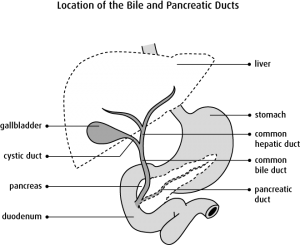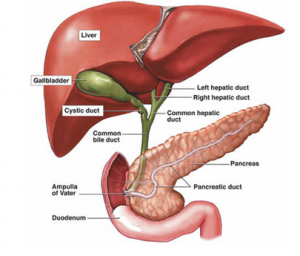The common bile duct is a small, tube-like structure formed where the common hepatic duct and the cystic duct join. Its role is to carry bile from the gallbladder and empty it into the upper part of the small intestine. The common bile duct is part of the biliary system.
 Bile is a greenish-brown fluid that helps digest fats from our food intake. It is produced by the liver and stored and concentrated in the gallbladder until it is needed to help digest foods. When food enters the small intestine, bile travels through the common bile duct to reach the duodenum.
Bile is a greenish-brown fluid that helps digest fats from our food intake. It is produced by the liver and stored and concentrated in the gallbladder until it is needed to help digest foods. When food enters the small intestine, bile travels through the common bile duct to reach the duodenum.
Gallstones are hard deposits that form inside the gallbladder when there is too much bilirubin or cholesterol in the bile. Although a person may have gallstones for many years without feeling any symptoms, gallstones can sometimes pass through the common bile duct, causing inflammation and severe pain. If a gallstone blocks the common bile duct, it can cause choledocholithiasis.
Treatments may include:
- Stone extraction
- Fragmenting stones
- Surgery to remove the gallbladder and stones (cholecystectomy)
- Surgery that makes a cut into the common bile duct to remove stones or help them pass
- Biliary stenting
Cholecystectomy
Gall bladder removal (cholecystectomy) is a common surgical procedure in most hospitals.
The vast majority of gall bladders are removed laparoscopically otherwise known as keyhole surgery. The laparoscopic method does not require a large incision.
 Usually this is an outpatient procedure, which allows the patient to return home the day of surgery, and has a two or three day recovery period.
Usually this is an outpatient procedure, which allows the patient to return home the day of surgery, and has a two or three day recovery period.
In removing the gall bladder, the surgeon clips the cystic duct in two places. One is near the cystic duct’s juncture with the gallbladder, and the second is at the cystic duct’s juncture with the common bile duct. The surgeon similarly clips the cystic artery.
The surgeon then cuts the cystic duct and artery between the two clips. By transecting the cystic duct and artery, the surgeon frees the gall bladder for removal.
The surgeon must find and identify the cystic duct’s juncture with the gall bladder and the cystic duct’s juncture with the common bile duct before cutting the cystic duct. The surgeon accomplishes this by finding the gall bladder and the cystic duct juncture; and then meticulously tracing the cystic duct to its junction with the common bile duct.
The objective is to identify the cystic duct conclusively. The surgeon must not clip the cystic duct before making conclusive identification of the cystic duct.
Iatrogenic Injury
Unfortunately, laparoscopic cholecystectomies do not always go as planned.
The most common mistake is that the surgeon clips or cuts the patient’s common bile duct instead of the cystic duct (known as iatrogenic injury). This injury usually requires extensive, complicated and painful surgery to reconstruct the patient’s biliary anatomy.
After reconstructive surgery, the patient is at risk of scarring of the reconstructed biliary tract and further reconstructive surgery. In the worst case scenario, the patient can develop liver failure and die.
The surgeon must conclusively identify the cystic duct before clipping. If the surgeon makes the conclusive identification, the gall bladder injury will not occur.
The attorneys at Carr & Carr focus on that one issue – the surgeon failed to conclusively identify the cystic duct. As a result, the surgeon may have placed clips across the common bile duct, obstructing the flow of bile or cut the patient’s common bile duct, resulting in the flow of bile into the patient’s abdomen with consequent sepsis.
The Oklahoma medical malpractice lawyers at Carr & Carr can help if you or a loved one has been a victim of medical negligence. Call us at 866-510-0580 or contact us online to schedule your free, no-obligation consultation. Our law firm maintains offices in Tulsa and Oklahoma City, but our attorneys can also meet you at your home, hospital room or other location convenient for you.





